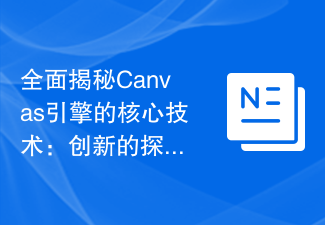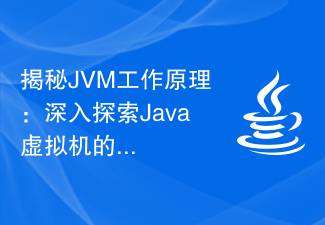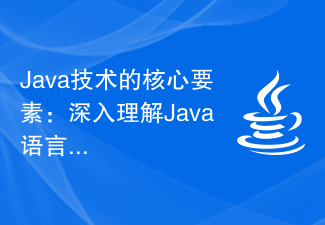
The Java Virtual Machine (JVM) is the key to the Java language's ability to "write once and run on multiple platforms". Java code is compiled into bytecode, and then the JVM interprets and executes the bytecode, which is cross-platform and ensures operational security and stability. Therefore, a deep understanding of the core technology of JVM is crucial for Java developers. This article will introduce the main components of JVM and its working principle in detail, and give specific Java code examples to help readers better understand.
Main components of JVM
JVM is mainly composed of the following components:
1. Class loader (ClassLoader)
ClassLoader is a very important component in JVM. An important component whose main job is to dynamically load bytecode files into memory at runtime and convert them into Java classes. ClassLoader is divided into three types: startup class loader, extension class loader and application class loader.
In the following code example, we define a Java class named com.example.Test and use ClassLoader to load it:
public class ClassLoaderDemo {
public static void main(String[] args) {
ClassLoaderDemo demo = new ClassLoaderDemo();
ClassLoader classLoader = demo.getClass().getClassLoader();
try {
Class clazz = classLoader.loadClass("com.example.Test");
System.out.println("Class " + clazz.getName() + " loaded by " + clazz.getClassLoader());
} catch (ClassNotFoundException e) {
e.printStackTrace();
}
}
}2. Runtime data area (Runtime Data Area)
JVM stores runtime data through the runtime data area. It is divided into several parts such as method area, heap, stack, program counter and local method stack.
- Method area: stores loaded class information, constants, static variables and compiler-generated code, etc.
- Heap: stores dynamically allocated object instances. Heap allocation and recycling are the core of Java's garbage collection mechanism.
- Stack: stores local variables, method parameters, operand stacks (temporary variables used when executing methods) of each thread, etc. Each method creates a stack frame when it is executed, and the stack frame is destroyed when the method ends.
- Program counter: records the address of the bytecode instruction being executed by the current thread.
- Native method stack: Similar to a stack, it is used to store information such as parameters and return values when each thread calls a local (Native) method.
3. Bytecode execution engine (Execution Engine)
The bytecode execution engine is the core component of the JVM. It is responsible for interpreting and executing Java bytecode, and can also Bytecode is compiled into native machine instructions for execution. The bytecode execution engine usually uses an interpreter to execute the bytecode, but for frequently executed methods, it will use a just-in-time compiler (JIT) to compile the bytecode into local machine instructions to Improve program performance.
4. Garbage Collector
The Java garbage collection mechanism solves memory management problems by automatically detecting objects that are no longer used and recycling them. The JVM's garbage collector stores unused objects in the heap and periodically scans the objects in the heap to find out the no longer used objects and recycle them.
The following is a simple Java code example that demonstrates how to create a useless object and trigger the garbage collection mechanism:
public class GarbageCollectionDemo {
public static void main(String[] args) {
for (int i = 0; i < 10000; i++) {
Object obj = new Object();
// do something with obj
}
System.gc(); // explicitly trigger garbage collection
}
}How the JVM works
In Java When the application starts, the JVM will first load the Java class and interpret and execute the bytecode. When executing bytecode, the JVM interprets the bytecode line by line into machine instructions that the operating system can recognize and execute. The data required by the bytecode is stored in the runtime data area and memory is allocated and released in the heap. If local methods are used in the program, you also need to use the local method stack to call the local method.
The JVM automatically recycles no longer used objects and releases memory through the garbage collector. If there is insufficient memory, the JVM will throw an OutOfMemoryError exception. During the life cycle of the JVM, the JVM executes Java bytecode through the execution engine and loads other dependent classes through the class loader.
The following code demonstrates how the class loader works:
public class ClassLoaderDemo {
public static void main(String[] args) {
ClassLoaderDemo demo = new ClassLoaderDemo();
ClassLoader classLoader = demo.getClass().getClassLoader();
try {
Class clazz = classLoader.loadClass("com.example.Test");
System.out.println("Class " + clazz.getName() + " loaded by " + clazz.getClassLoader());
} catch (ClassNotFoundException e) {
e.printStackTrace();
}
}
}In this example, we loaded the Test class through ClassLoader. ClassLoader will first search for classes contained in the classpath, and if it cannot be found, it will delegate the search to the parent class loader. If all parent class loaders cannot find the class, the application class loader (Application Class Loader) will eventually load the class. Before loading, ClassLoader also verifies the bytecode to ensure its safety and correctness.
Summary
JVM plays a vital role in Java development. Its working principle determines that Java can run across platforms and ensures the security and stability of the program. JVM consists of components such as class loader, runtime data area, bytecode execution engine, and garbage collector. Each component has different roles and functions. Understanding these components is very important for Java developers, and specific code examples are needed to deepen the understanding of the JVM.
The above is the detailed content of In-depth understanding of JAVA core virtual machine technology. For more information, please follow other related articles on the PHP Chinese website!
 全面指南:详解Java虚拟机安装过程Jan 24, 2024 am 09:02 AM
全面指南:详解Java虚拟机安装过程Jan 24, 2024 am 09:02 AMJava开发必备:详细解读Java虚拟机安装步骤,需要具体代码示例随着计算机科学和技术的发展,Java语言已成为广泛使用的编程语言之一。它具有跨平台、面向对象等优点,逐渐成为开发人员的首选语言。在使用Java进行开发之前,首先需要安装Java虚拟机(JavaVirtualMachine,JVM)。本文将详细解读Java虚拟机的安装步骤,并提供具体的代码示
 使用宝塔面板进行Java虚拟机的优化配置Jun 21, 2023 pm 02:52 PM
使用宝塔面板进行Java虚拟机的优化配置Jun 21, 2023 pm 02:52 PM随着互联网的不断发展,越来越多的应用与业务都需要使用到Java语言开发的程序。而对于Java程序的运行,Java虚拟机(JVM)的性能就显得非常重要。因此,进行优化配置是提高Java应用程序性能的重要手段。宝塔面板是一款常用的服务器控制面板,可以帮助用户更方便地进行服务器管理。本文将介绍如何使用宝塔面板对Java虚拟机进行优化配置。第一步:安装Java虚拟机
 全面揭秘Canvas引擎的核心技术:创新的探索Jan 17, 2024 am 10:21 AM
全面揭秘Canvas引擎的核心技术:创新的探索Jan 17, 2024 am 10:21 AM探索创新:全面解析Canvas引擎的核心技术引言:随着移动设备和互联网的普及,现代应用程序对于图形渲染的需求变得越来越重要。而HTML5的引入为我们提供了一种强大的绘图工具——Canvas。Canvas是一个基于HTML5标准的绘图工具,它提供了一套丰富的API以实现矢量绘图、位图渲染等功能。本文将深入探索Canvas引擎的核心技术,包括绘图原理、坐标系转换
 Java虚拟机如何使用引用计数进行内存管理?Apr 13, 2024 am 11:42 AM
Java虚拟机如何使用引用计数进行内存管理?Apr 13, 2024 am 11:42 AMJava虚拟机利用引用计数管理内存使用,当对象的引用计数达到0时,JVM会进行垃圾回收。引用计数机制包括:每个对象拥有计数器,存储指向该对象的引用数量。创建对象时,引用计数器设为1。引用对象时,引用计数器增加。引用结束时,引用计数器减少。
 Java虚拟机中的栈帧结构和作用Apr 14, 2024 am 08:03 AM
Java虚拟机中的栈帧结构和作用Apr 14, 2024 am 08:03 AM栈帧在Java虚拟机(JVM)中是执行方法的基础数据结构,包含以下部分:局部变量表:存储方法的局部变量。操作数堆栈:存放操作数和中间结果。帧数据:包含返回地址和当前程序计数器。栈帧的作用包括:存储局部变量。执行操作数操作。处理方法调用。协助异常处理。辅助垃圾回收。
 揭秘JVM工作原理:深入探索Java虚拟机的原理Feb 18, 2024 pm 12:28 PM
揭秘JVM工作原理:深入探索Java虚拟机的原理Feb 18, 2024 pm 12:28 PMJVM原理详解:深入探究Java虚拟机的工作原理,需要具体代码示例一、引言随着Java编程语言的迅猛发展和广泛应用,Java虚拟机(JavaVirtualMachine,简称JVM)也成为了软件开发中不可或缺的一部分。JVM作为Java程序的运行环境,能够提供跨平台的特性,使得Java程序能够在不同的操作系统上运行。在本文中,我们将深入探究JVM的工作原
 详解Java虚拟机安装过程:手把手教你安装步骤Jan 05, 2024 pm 03:58 PM
详解Java虚拟机安装过程:手把手教你安装步骤Jan 05, 2024 pm 03:58 PMJava虚拟机安装指南:一步步教你如何安装,需要具体代码示例引言:Java虚拟机(JavaVirtualMachine,简称JVM)是一种能够运行Java字节码的虚拟机器。它是Java技术的核心组成部分,也是Java应用能够跨平台运行的关键。在本文中,我们将一步步教你如何安装Java虚拟机,并提供具体的代码示例,以帮助你快速上手。一、下载JavaDev
 Java技术的核心要素:深入理解Java语言、Java虚拟机和Java SE库Dec 26, 2023 am 10:28 AM
Java技术的核心要素:深入理解Java语言、Java虚拟机和Java SE库Dec 26, 2023 am 10:28 AMJava核心技术栈:深入了解Java语言、Java虚拟机和JavaSE库随着计算机科学和技术的不断发展,Java语言成为全球最受欢迎的编程语言之一。作为一种跨平台的高级编程语言,Java在各个领域都得到了广泛应用,尤其是在企业级应用开发和云计算领域。要成为一名优秀的Java开发人员,必须熟练掌握Java核心技术栈,即Java语言、Java虚拟机和Java


Hot AI Tools

Undresser.AI Undress
AI-powered app for creating realistic nude photos

AI Clothes Remover
Online AI tool for removing clothes from photos.

Undress AI Tool
Undress images for free

Clothoff.io
AI clothes remover

AI Hentai Generator
Generate AI Hentai for free.

Hot Article

Hot Tools

Zend Studio 13.0.1
Powerful PHP integrated development environment

Dreamweaver CS6
Visual web development tools

EditPlus Chinese cracked version
Small size, syntax highlighting, does not support code prompt function

ZendStudio 13.5.1 Mac
Powerful PHP integrated development environment

SublimeText3 Linux new version
SublimeText3 Linux latest version






